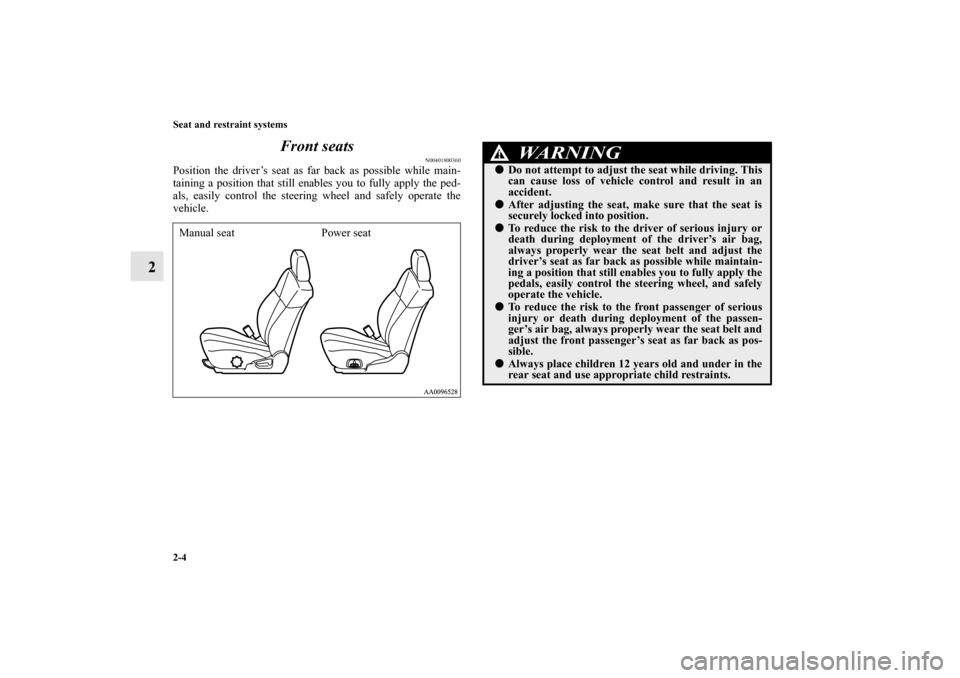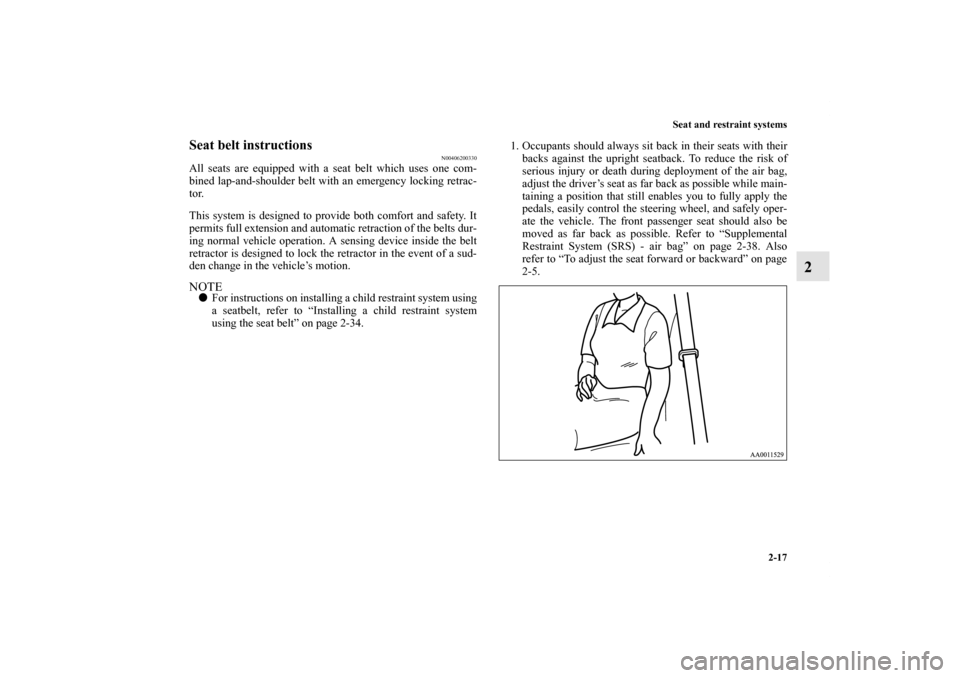Page 31 of 424

2-4 Seat and restraint systems
2Front seats
N00401800360
Position the driver’s seat as far back as possible while main-
taining a position that still enables you to fully apply the ped-
als, easily control the steering wheel and safely operate the
vehicle.
Power seat Manual seat
WA R N I N G
!�Do not attempt to adjust the seat while driving. This
can cause loss of vehicle control and result in an
accident. �After adjusting the seat, make sure that the seat is
securely locked into position.�To reduce the risk to the driver of serious injury or
death during deployment of the driver’s air bag,
always properly wear the seat belt and adjust the
driver’s seat as far back as possible while maintain-
ing a position that still enables you to fully apply the
pedals, easily control the steering wheel, and safely
operate the vehicle.�To reduce the risk to the front passenger of serious
injury or death during deployment of the passen-
ger’s air bag, always properly wear the seat belt and
adjust the front passenger’s seat as far back as pos-
sible. �Always place children 12 years old and under in the
rear seat and use appropriate child restraints.
BK0121200US.book 4 ページ 2010年4月14日 水曜日 午前11時24分
Page 32 of 424
Seat and restraint systems
2-5
2
To adjust the seat forward or backward
N00401900299
Manual seatPull the seat adjusting lever up and slide the seat forward or
backward to the desired position. Release the adjusting lever to
lock the seat in place.
CAUTION
!�Make sure that the seat is adjusted by an adult. If it
is adjusted by a child, an unexpected accident might
occur.�Do not place a cushion or the like between your back
and the seatback while driving. The effectiveness of
the head restraints will be reduced in the event of an
accident.�When sliding the seats, be careful not to catch your
hand or leg.�When sliding or reclining the seat rearward, pay
careful attention to the rear seat passengers.
WA R N I N G
!�To make sure that the seat is securely locked, try to
move it forward or backward without using the
adjusting lever.
BK0121200US.book 5 ページ 2010年4月14日 水曜日 午前11時24分
Page 33 of 424
2-6 Seat and restraint systems
2
Power seatPush the switch to adjust the seat forward or backward to the
desired position. Release the switch, and the seat will lock at
that position.NOTE�To prevent the battery from running down, operate the
power seat with the engine running.
To adjust the seatback
N00402000330
Manual seatTo adjust the seatback, lean forward slightly, gently pull the
seatback lock lever up, then lean backward to a comfortable
position and release the lever. The seatback will lock in place.
1- Forward (towards the front of the vehicle)
2- Backward (towards the rear of the vehicle)
CAUTION
!�The reclining mechanism used in the seatback is
spring loaded, and will cause the seatback to return
quickly to the vertical position when the lock lever is
operated. When pulling the lever, sit close to the
seatback or hold the seatback with your hand to
control its return motion.
BK0121200US.book 6 ページ 2010年4月14日 水曜日 午前11時24分
Page 40 of 424

Seat and restraint systems
2-13
2
Adjustment of the head restraint heightTo reduce the risk of injury in an accident, adjust the head
restraint height so that the center of the restraint is at your eye
level when seated. Any person too tall for the restraint to reach
their eye level when seated should raise the restraint to the
highest locked position.
�To raise the restraint, pull it straight up.
�To lower the restraint, push down on it while pressing the
lock knob (A) in the direction shown by the arrow.
�After adjusting the height, push down on the restraint to
make sure it is locked in position.
WA R N I N G
!�In order to minimize the risk of a neck injury due to
a rear impact, the seatback must be adjusted to the
upright position and the head restraint must be
adjusted to the proper position before vehicle opera-
tion.
The driver should never adjust the seat while the
vehicle is in motion.�Driving without the head restraints in place can
cause you and your passengers serious injury or
death in an accident. To reduce the risk of injury in
an accident, always make sure the head restraints
are installed and properly positioned when the seat
is occupied. �Never place a cushion or similar device on the
seatback. This can adversely affect head restraint
performance by increasing the distance between
your head and the restraint.
BK0121200US.book 13 ページ 2010年4月14日 水曜日 午前11時24分
Page 41 of 424
2-14 Seat and restraint systems
2
To removePress the lock knob (A) in the direction shown by the arrow.
Then pull the head restraint up and out of the seatback.To installFirst check that the head restraint is facing in the right direction
as shown in the previous illustration, and then insert it into the
seatback. Push the head restraint down while pressing the lock
knob (A) until the restraint locks into place.
WA R N I N G
!�To help minimize the risk of neck injury in the event
of an accident, the head restraints must be properly
installed and positioned to proper height before
vehicle operation.
CAUTION
!�Check that the lock knob (A) is extended out as
shown in the illustration. Then pull the head
restraint up to make sure that it is locked in place
and will not come out of the seatback.
BK0121200US.book 14 ページ 2010年4月14日 水曜日 午前11時24分
Page 44 of 424

Seat and restraint systems
2-17
2
Seat belt instructions
N00406200330
All seats are equipped with a seat belt which uses one com-
bined lap-and-shoulder belt with an emergency locking retrac-
tor.
This system is designed to provide both comfort and safety. It
permits full extension and automatic retraction of the belts dur-
ing normal vehicle operation. A sensing device inside the belt
retractor is designed to lock the retractor in the event of a sud-
den change in the vehicle’s motion. NOTE�For instructions on installing a child restraint system using
a seatbelt, refer to “Installing a child restraint system
using the seat belt” on page 2-34.1. Occupants should always sit back in their seats with their
backs against the upright seatback. To reduce the risk of
serious injury or death during deployment of the air bag,
adjust the driver’s seat as far back as possible while main-
taining a position that still enables you to fully apply the
pedals, easily control the steering wheel, and safely oper-
ate the vehicle. The front passenger seat should also be
moved as far back as possible. Refer to “Supplemental
Restraint System (SRS) - air bag” on page 2-38. Also
refer to “To adjust the seat forward or backward” on page
2-5.
BK0121200US.book 17 ページ 2010年4月14日 水曜日 午前11時24分
Page 46 of 424
Seat and restraint systems
2-19
2
3. Pull the seat belt out slowly while holding the latch plate.
Push the latch plate into the buckle until you hear a
“click”. Pull up on the belt to be sure the latch plate is
locked securely in the buckle.NOTE�If the seat belt locks up and cannot be pulled out, pull it
once with force and let it retract all the way.
Then, pull the belt out slowly once again.4. The lap part of the belt must always be worn low and snug
across the hips. Pull up on the shoulder portion of the belt
to take up any slack in the lap belt.
BK0121200US.book 19 ページ 2010年4月14日 水曜日 午前11時24分
Page 47 of 424

2-20 Seat and restraint systems
2
NOTE�With the exception of the seat belt for the driver, the seat
belts in all other seating positions are equipped with an
Automatic Locking Retractor (ALR) function. If you pull
the seat belt fully out of the retractor, the retractor will
switch to its ALR child restraint installation function (see
page 2-34). When the ALR function has been activated,
the seat belt will only retract. If this happens, let the belt
fully retract, then pull the seat belt back out, repeating
steps 1 through 4.
5. To release the belt, press the button on the buckle and
allow the belt to retract.
If the belt does not retract smoothly, pull it out and check
for kinks or twists in the webbing. Then make sure it
remains untwisted as it retracts.
Driver’s seat belt reminder/warning light
N00418400153
A tone and warning light are used to remind the driver to fasten
the seat belt.
When the ignition key is turned to the “ON” position, the warn-
ing light will come on and a tone will sound for about 6 sec-
onds. If the driver’s seat belt remains unfastened
approximately 1 minute later, the warning light will flash and
the tone will sound intermittently (12 times each) when the
vehicle is driven. If the driver subsequently unfastens the seat
belt while driving, the warning light and tone will issue further
warnings. And if the seat belt remains unfastened, the warning
light and tone will issue further warnings each time the vehicle
starts moving from a stop. When the seat belt is fastened, the
warnings will stop.
WA R N I N G
!�Be sure the lap belt portion fits snugly and is worn
as low as possible across the hips, not around the
waist. Failure to follow this instruction will increase
the risk of serious injury or death in the event of an
accident.�Be sure the seat belt webbing is not twisted when
worn. Twisted webbing may adversely affect seat
belt performance.
BK0121200US.book 20 ページ 2010年4月14日 水曜日 午前11時24分